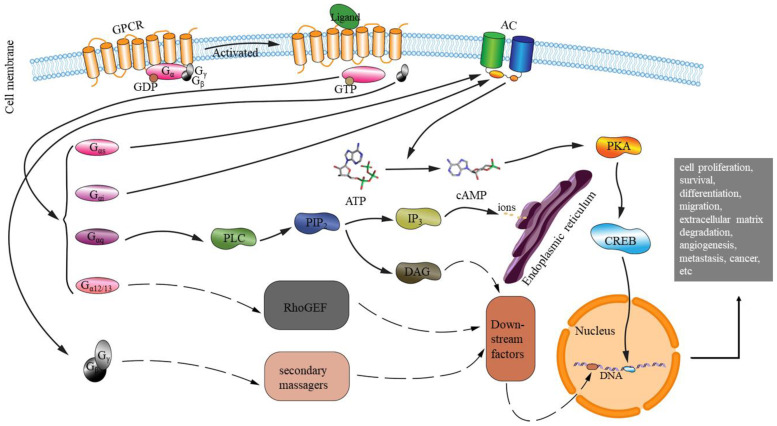Figure 1.
Graphical representation of the locations of GPCR regulatory pathways. GPCRs can be activated by a variety of ligands, interacting with heterotrimeric G-proteins composed of three subunits (Gα, Gβ, and Gγ) [95], and activating several downstream effector molecules [95]. Gα subunits are classified into four subfamilies: Gαs, Gαi, Gαq, and Gα12/13 [99,100] and can activate adenylyl cyclase (AC) [101], cyclic adenosine monophosphate (cAMP) [102,103,104], cAMP regulated proteins such as protein kinase A (PKA or cAMP-dependent protein kinase) [105], cyclic nucleotide-gated channels [106], and others [102,104,107], initiating and coordinating intracellular signaling pathways. Gαq can also activate phospholipase C (PLC), which can cleave phosphatidylinositol bisphosphate (PIP2) into diacylglycerol and inositol triphosphate (IP3) and membrane-bound diacylglycerol (DAG) [104,108,109,110]. IP3 can open the channel on the endoplasmic reticulum membrane [111], and DAG can activate protein kinase C [104,110]. Within the Gα12/13 family, G-α13 can increase the activation of p115RhoGEF (the Rho guanine nucleotide exchange factor) and related RhoGEF proteins linked to the Rho activation [112]. Several proteins are known to interact with Gα12, including Btk-family tyrosine kinase, Ras GTPase activating protein, cadherins, p120-caterin, and others [95,104,113,114,115,116,117]. Gβγ subunits can also send signals to phospholipase C, voltage gated Ca2+ channels, and others.

